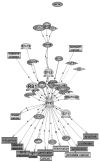Comparative mitochondrial proteomic analysis of Rji cells exposed to adriamycin
- PMID: 19209238
- PMCID: PMC2637758
- DOI: 10.2119/molmed.2008.00129
Comparative mitochondrial proteomic analysis of Rji cells exposed to adriamycin
Abstract
The antitumor mechanisms of adriamycin (ADR) have been thought to contribute to induction of apoptosis and inefficiency of DNA repair, processes that are to a large extent mediated by mitochondria. This study aimed to investigate characteristics of ADR, including its antineoplastic activity, drug resistance, and unexpected toxicity in non-Hodgkin lymphoma (NHL) Raji cells at the mitochondrial proteomic level. The alterations of the mitochondrial proteome of Raji cells treated with ADR were analyzed by two-dimensional differential in-gel electrophoresis (2D-DIGE) coupled with linear ion trap quadrupole-electrospray ionization tandem mass spectrometry (LTQ-ESI-MS/MS).The altered patterns of three identified proteins were validated by Western blot and analyzed by pathway studio software. The results showed that 34 proteins were downregulated and 3 proteins upregulated in the study group compared with the control group. The differentially expressed proteins distributed their functions in reduction-oxidation reactions, DNA repair, cell cycle regulation, transporters and channels, and oxidative phosphorylation. Furthermore, heat shock protein 70 (HSP70), ATP-binding cassette transporter isoform B6 (ABCB6), and prohibitin (PHB) identified in this study may be closely related to chemoresistance and could serve as potential chemotherapeutic targets for NHL. Collectively, these results suggest that specific mitochondrial proteins are uniquely susceptible to alterations in abundance following exposure to ADR and carry implications for the investigation of therapeutic and prognostic markers. Further studies focusing on these identified proteins will be used to predict treatment response and reverse apoptosis resistance,and to explore drug-combination strategies associated with ADR for NHL therapy.
Figures





Similar articles
-
Mitochondrial proteomics with siRNA knockdown to reveal ACAT1 and MDH2 in the development of doxorubicin-resistant uterine cancer.J Cell Mol Med. 2015 Apr;19(4):744-59. doi: 10.1111/jcmm.12388. Epub 2015 Jan 30. J Cell Mol Med. 2015. PMID: 25639359 Free PMC article.
-
Comparative mitochondrial proteomic analysis of hepatocellular carcinoma from patients.Proteomics Clin Appl. 2013 Jun;7(5-6):403-15. doi: 10.1002/prca.201100103. Epub 2013 May 17. Proteomics Clin Appl. 2013. PMID: 23589362
-
Quantitative proteomics analysis identifies mitochondria as therapeutic targets of multidrug-resistance in ovarian cancer.Theranostics. 2014 Sep 18;4(12):1164-75. doi: 10.7150/thno.8502. eCollection 2014. Theranostics. 2014. PMID: 25285166 Free PMC article.
-
Identification of proteins responsible for the development of adriamycin resistance in human gastric cancer cells using comparative proteomics analysis.J Biochem Mol Biol. 2007 Nov 30;40(6):853-60. doi: 10.5483/bmbrep.2007.40.6.853. J Biochem Mol Biol. 2007. PMID: 18047778
-
Mitochondrial and nuclear p53 localization in cardiomyocytes: redox modulation by doxorubicin (Adriamycin)?Antioxid Redox Signal. 2007 Jul;9(7):1001-8. doi: 10.1089/ars.2007.1632. Antioxid Redox Signal. 2007. PMID: 17508921 Review.
Cited by
-
[The establishment of Raji drug-resistant cell line and analyses of prohibitin and miR-27a expression].Zhonghua Xue Ye Xue Za Zhi. 2015 Apr;36(4):326-30. doi: 10.3760/cma.j.issn.0253-2727.2015.04.015. Zhonghua Xue Ye Xue Za Zhi. 2015. PMID: 25916297 Free PMC article. Chinese.
-
Effects of arsenic sulfide (As2S2) on B and T lymphoma cell lines and possible underlying mechanisms.Biomed Rep. 2013 Jul;1(4):583-588. doi: 10.3892/br.2013.119. Epub 2013 May 30. Biomed Rep. 2013. PMID: 24648990 Free PMC article.
-
Cancer cell response to anthracyclines effects: mysteries of the hidden proteins associated with these drugs.Int J Mol Sci. 2012 Nov 22;13(12):15536-64. doi: 10.3390/ijms131215536. Int J Mol Sci. 2012. PMID: 23443080 Free PMC article.
-
PPAR signaling pathway and cancer-related proteins are involved in celiac disease-associated tissue damage.Mol Med. 2010 May-Jun;16(5-6):199-209. doi: 10.2119/molmed.2009.00173. Epub 2010 Mar 3. Mol Med. 2010. PMID: 20454521 Free PMC article.
-
DIGE Analysis Software and Protein Identification Approaches.Methods Mol Biol. 2023;2596:39-50. doi: 10.1007/978-1-0716-2831-7_3. Methods Mol Biol. 2023. PMID: 36378429
References
-
- Multani P, White CA, Grillo-Lopez A. Non-Hodgkin’s lymphoma: review of conventional treatments. Curr Pharm Biotechnol. 2001;2:279–91. - PubMed
-
- Armitage JO. Treatment of non-Hodgkin’s lymphoma. N Engl J Med. 1993;328:1023–30. - PubMed
-
- Parker SL, Tong T, Bolden S, Wingo PA. Cancer statistics. CA Cancer J Clin. 1997;47:5–27. - PubMed
-
- Patel S, Sprung AU, Keller BA, Heaton VJ, Fisher LM. Identification of yeast DNA topoisomerase II mutants resistant to the antitumor drug doxorubicin: implications for the mechanisms of doxorubicin action and cytotoxicity. Mol Pharmacol. 1997;52:658–66. - PubMed
-
- Singh V, Singh SM. Effect of high cell density on the growth properties of tumor cells: a role in tumor cytotoxicity of chemotherapeutic drugs. Anticancer Drugs. 2007;18:1123–32. - PubMed
Publication types
MeSH terms
Substances
LinkOut - more resources
Full Text Sources
Research Materials

